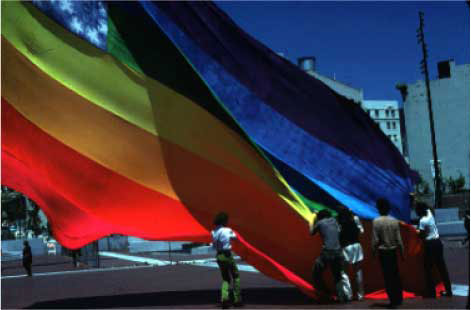
It turns out the LGBTQI+ movement had its own Betsy Ross—and he went to FIT. On Friday, June 26, 2015, within seconds of the Supreme Court’s ruling that same-sex marriage is a right bestowed by the Constitution, rainbow flags appeared everywhere. The symbol of gay pride was originally created in 1978 by artist and Vietnam veteran Gilbert Baker, with a little help from an FIT alum, James McNamara.
The Museum of Modern Art acquired the flag for its design collection in June. In an interview posted online, Baker told Paola Antonelli, a senior curator of architecture and design, that he got the idea for the flag during the American bicentennial: “[A]ll of a sudden [I saw] the American flag everywhere—from Jasper Johns paintings to trashy jeans in the Gap and tchotchkes.” When it came time to fabricate the rainbow versions, he knew he needed someone with sewing skills, so he turned to McNamara: “[H]e’d been to FIT, and was the only person who knew how to sew as well as I did.”
Before 1978, Baker said, the symbol of gay pride had been a pink triangle, which the Nazis had used to brand homosexuals as they did Jews, with a yellow star. But that was the problem: The triangle “came from such a horrible place of murder and holocaust and Hitler,” Baker said. “We needed something beautiful, something from us. The rainbow is so perfect because it really fits our diversity in terms of race, gender, ages, all of those things.” Baker constructed the flag with McNamara and others in San Francisco’s Gay Community Center, using cotton rinsed with natural dyes. Today it’s typically rendered in nylon so the colors don’t run; plus the material looks good with light streaming through it.
McNamara photographed the new design at its 1978 debut (see photo). As wonderful as the contemporary versions are, we can’t help longing to see one of the original, giant flags that McNamara helped create—symbols that appear as large and dramatic as the change they now celebrate.
